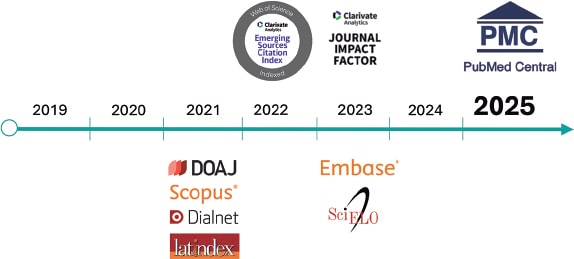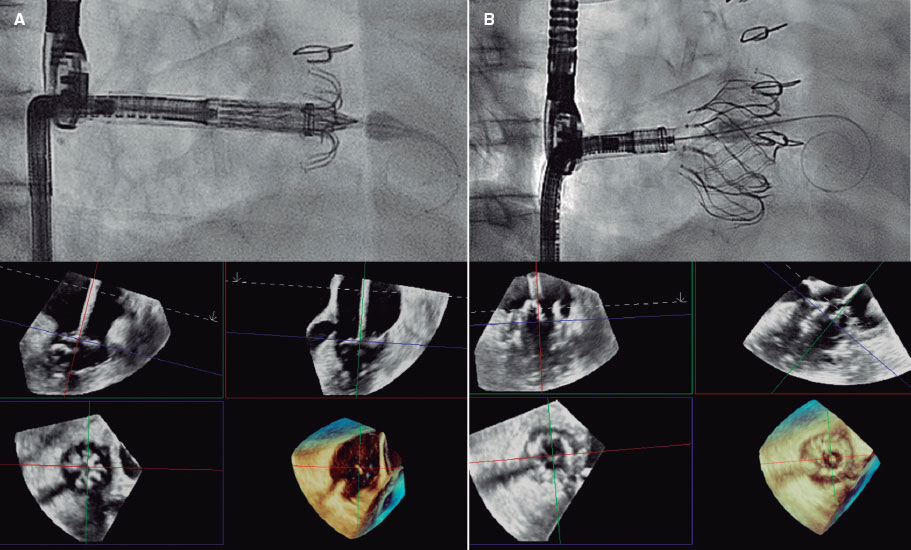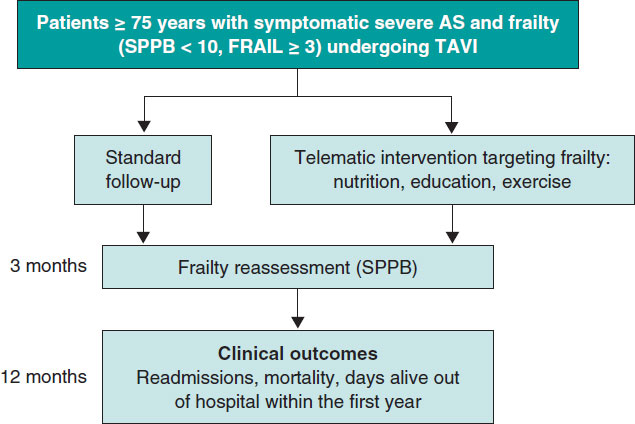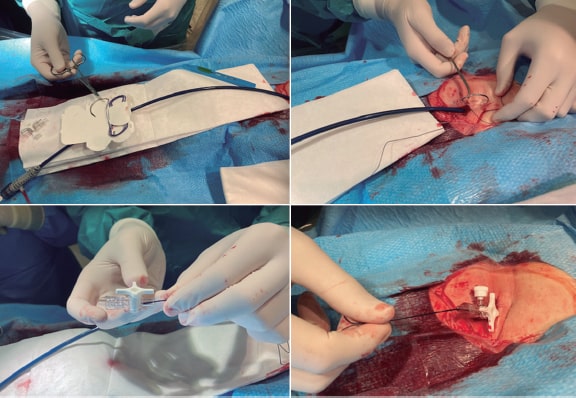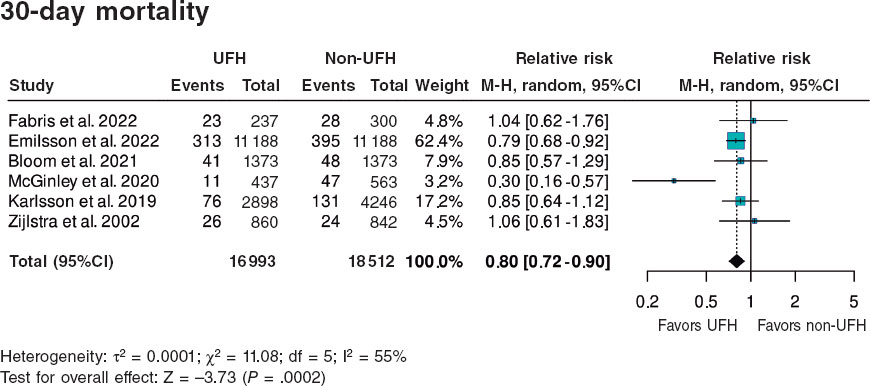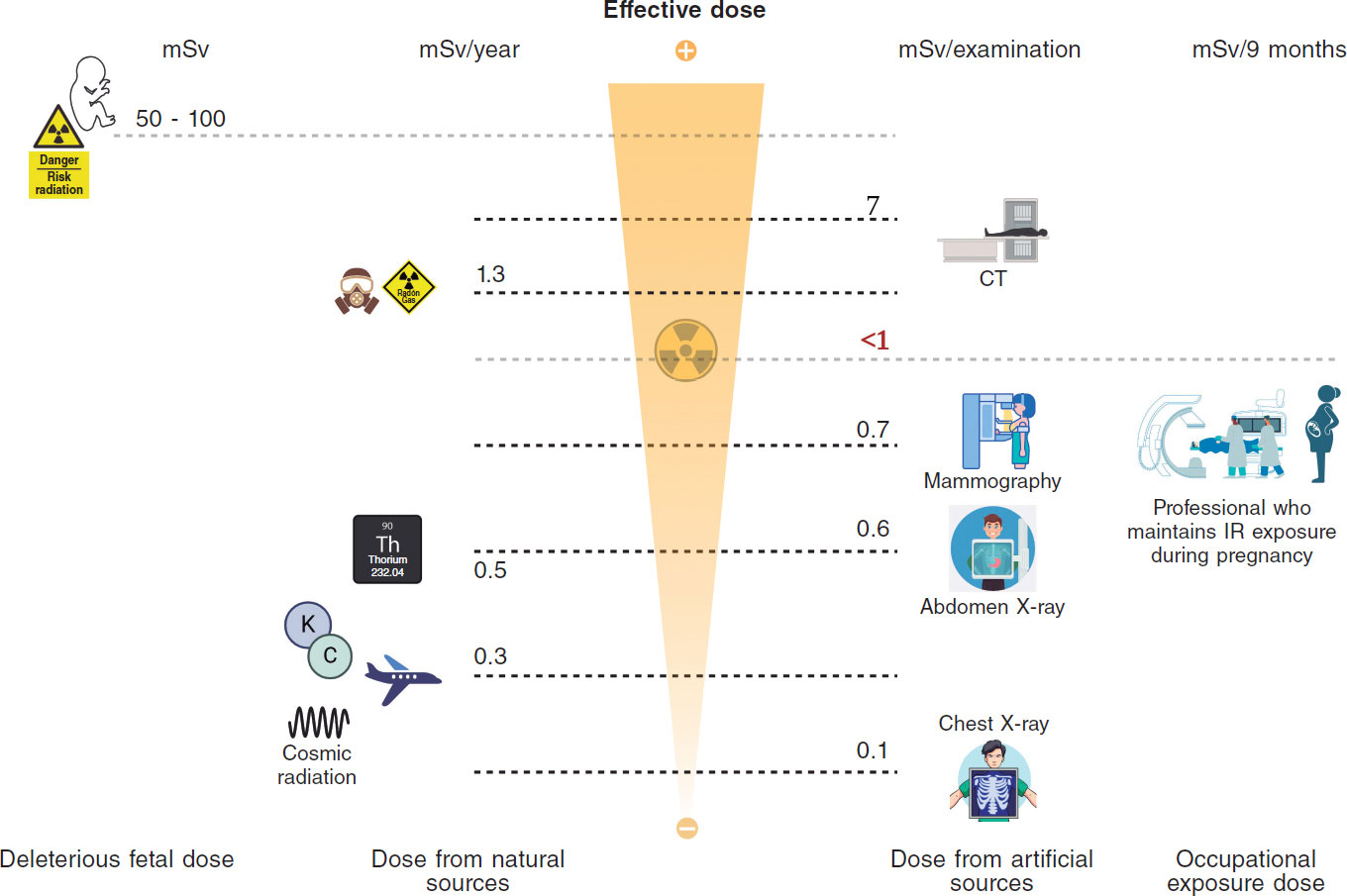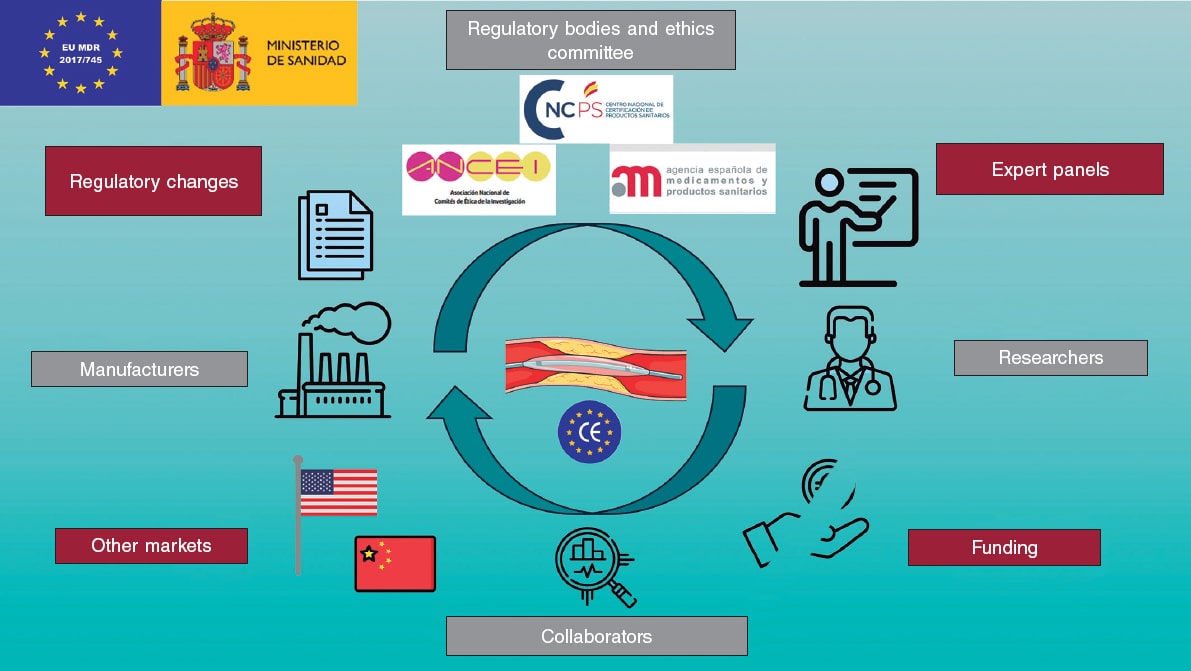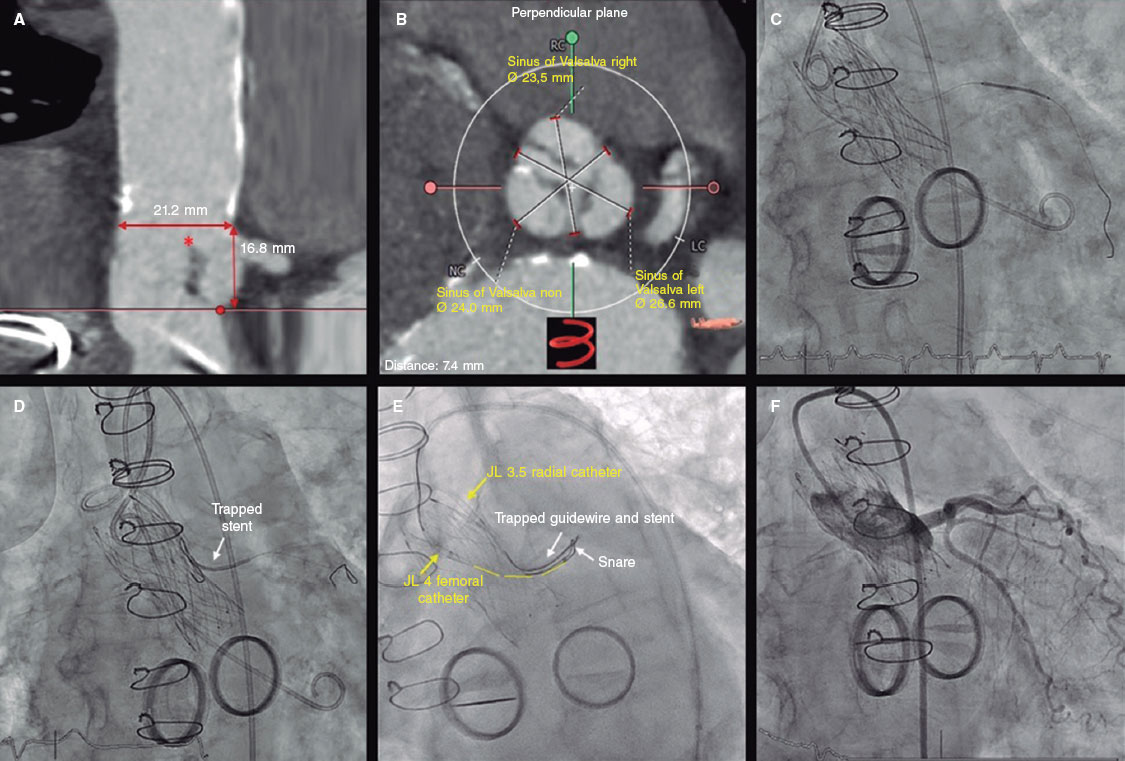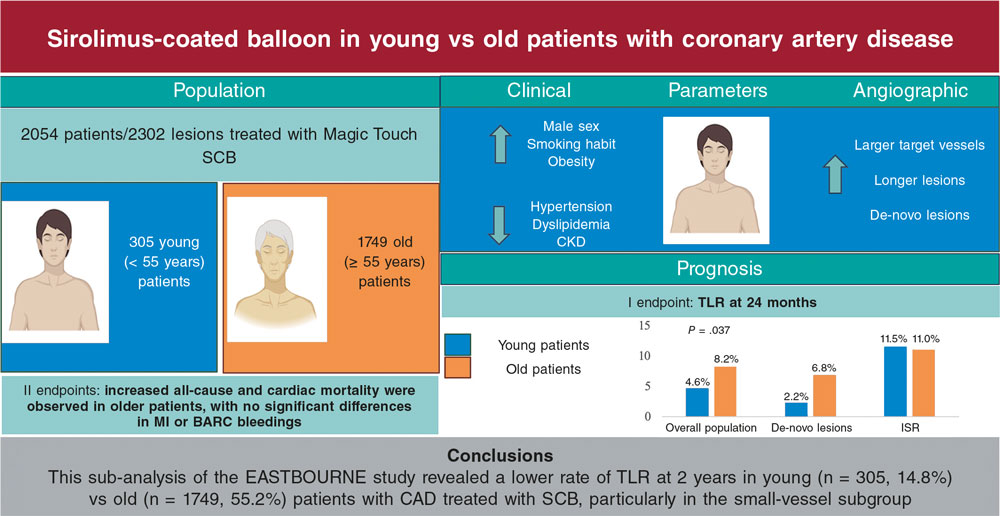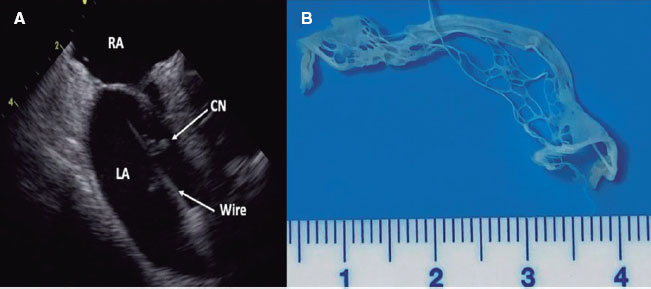To the Editor,
Heart transplantation remains the gold standard treatment for patients with advanced heart failure. However, over the past decade, waiting times for elective transplantation have increased, reaching a mean of 186 days, leading to clinical deterioration in these patients while awaiting an organ.1 Consequently, the use of temporary mechanical support devices has become a necessity. Although several options remain available, such as intra-aortic balloon pump, TandemHeart (CardiacAssist, United States), or extracorporeal membrane oxygenation (ECMO), the use of temporary percutaneous devices is on the rise.2 One of these temporary percutaneous devices, the Impella CP, has already been successfully utilized for this purpose.3,4 Although there are several versions of the Impella device (2.5, CP, 5.0) each with its own limitations, the recently introduced 5.5 offers advantages, such as high flow, an average support duration of 1 month, and axillary implantation.
The emergence of the new high-flow axillary Impella devices—5.0 and 5.5—with a CE-marked duration of up to 1 month and their equivalence to surgical assist devices requiring sternotomy, such as Levitronix (Switzerland), in terms of emergency criteria for organ allocation, minimizing associated morbidity, has changed the landscape of emergency heart transplantation.5 Several experiences using the Impella 5.5 strategy for temporary mechanical support as a bridge to transplantation with good outcomes have been reported.6 The aim of this scientific letter is to present, for the first time in Spain, the experience of a single center.
In Spain, the first Impella 5.5 device was implanted at our center back in January 2022. Since then, until April 2024, a total of 11 devices have been implanted in patients with cardiogenic shock as a bridge to heart transplantation. Fluoroscopy and transesophageal echocardiography-guided implantation is usually performed in the operating room by a heart team including 1 interventional cardiologist, multiple cardiac surgeons, and 1 cardiologist specialized in advanced heart failure. The axillary approach is used to facilitate mobilization and functional recovery during hospital admission (figure 1).

Figure 1. Illustration of situations related to high-flow Impella. A: echocardiogram of an Impella 5.5 device. B: surgical implantation of an Impella device through an axillary “Y” graft, with a second access if emergency ECMO cannulation is required. C: carrier of an axillary-implanted Impella undergoing functional rehabilitation.
In the study presented here, the SPSS program (IBM, United States) was used for data statistical analysis. Continuous variables are expressed as mean and standard deviation, except for the variable of support days which is expressed as median and interquartile range. The paired Student’s t-test was used for variable comparison.
Table 1 illustrates the patients’ baseline characteristics. A total of 33% were already on the heart transplant waiting list, and all of them had been hospitalized due to cardiogenic shock. In only 1 case was the Impella device implanted as a step-down from previous support with ECMO plus intra-aortic balloon pump. The most common cause was non-ischemic dilated cardiomyopathy, followed by ischemic heart disease. The patient profile was male (90.9%), with a conventional body surface area and left ventricular dilation and dysfunction, but most with preserved right ventricular function (3 patients exhibited tricuspid annular plane systolic excursion (TAPSE) < 14 mm and other signs of significant right ventricular dysfunction).
After implantation, all patients were extubated early (< 12 h), except for one (at 48h) due to pulmonary congestion. Median support time was 12 days [10.5-44], exceeding the recommended time in 4 cases (39, 49, 59, and 78 days), while the median time in the urgent transplant list was 7 days (discrepancy is due to the organ recovery phase required in some patients). Despite this, only 2 patients required device replacement, the first 58 days following support due to purge system failure and the second 28 days later due to surgical wound infection (the contralateral approach was chosen in this case).
The most relevant complications were 2 strokes and 2 episodes of GI bleeding. The index stroke was ischemic, in the distal left M1 territory, 1 day after device replacement (58 days following support) and was resolved with mechanical thrombectomy without sequelae. The second was also ischemic (12 days after support) in the right capsulothalamic territory and was resolved uneventfully as well. There were no episodes of hemolysis despite the high flows generated, which could be an advantage of this device.
The hemodynamic improvement observed 48 hours after implantation was clinically significant (table 1), with a 50% reduction in mean pulmonary artery pressure, which turned 3 patients previously contraindicated for transplantation due to highly resistant pulmonary arterial hypertension into eligible candidates. The median time in the emergency department was 7 [3.5-14.5] days. Transplantation was successfully performed in all patients, without right or primary graft failure. After transplantation, a total of 83% of patients were extubated within the first 24 hours, with a median length of intensive care unit stay of 7.5 days [6.25-8.75]. One patient died during hospitalization due to pulmonary aspergillosis, and the rest were uneventfully discharged (in-hospital survival rate of 90.9%).
Table 1. Baseline characteristics of patients supported with high-flow subclavian Impella as a bridge to heart transplantation
| Baseline features (n = 11) | n (%) or mean ± SD | P |
|---|---|---|
| Clinical features | ||
| Etiology | ||
| Non-ischemic dilated | 5 (45.5%) | - |
| Ischemic | 4 (36.4%) | |
| Hypertrophic | 2 (18.2%) | |
| INTERMACS | ||
| 1 | 1 (9.1%) | - |
| 2 | 5 (45.5%) | |
| 3 | 5 (45.5%) | |
| SCAI | ||
| C | 9 (81.8%) | - |
| D | 2 (18.2%) | |
| Inotropic-vasoactive score prior to implantation | 7.89 ± 9.4 | - |
| Age (years) | 59 ± 5.9 | - |
| Male | 10 (90.9%) | - |
| Height (cm) | 173.1 ± 8.35 | - |
| Weight (kg) | 72.3 ± 8.9 | - |
| Support time (days) | 12 [10.5-44] | - |
| Echocardiographic features | ||
| LVEF (%) | 24.2 ± 7.46 | - |
| TAPSE (mm) | 19.4 ± 3 | - |
| LVEDV (mL) | 224.1 ± 77 | - |
| Hemodynamic features | ||
| Pre-mPAP (mmHg) | 40.8 ± 11.8 | < .001 |
| Post-mPAP* (mmHg) | 21.1 ± 8.8 | |
| Pre-PCWP* (mmHg) | 29.6 ± 7.35 | < .001 |
| Post-PCWP* (mmHg) | 12.5 ± 5.5 | |
| Pre-TPG* (mmHg) | 11.8 ± 6.2 | .056 |
| Post-TPG* (mmHg) | 8.67 ± 5.2 | |
| Pre-CI* (L/min/m²) | 2.2 ± 0.8 | .102 |
| Post-CI* (L/min/m²) | 2.75 ± 1.27 | |
|
CI, cardiac index; INTERMACS, Interagency Registry for Mechanically Assisted Circulatory Support; LVEDV, left ventricular end-diastolic volume; LVEF, left ventricular ejection fraction; mPAP, mean pulmonary artery pressure; PCWP, pulmonary capillary wedge pressure; SCAI, Society for Cardiovascular Angiography & Interventions; SD, standard deviation; TAPSE, tricuspid annular plane systolic excursion; TPG, transpulmonary pressure gradient. Data expressed as n (%), mean ± standard deviation, or median [interquartile range]. * 48 hours after implantation. |
||
Regarding the limitations of our work, this is a small patient cohort, which means that result validity is limited. On the other hand, different treatment strategies were not compared, which means that the superiority of the presented strategy over the others cannot be inferred.
In conclusion, the Impella device—5.0 and 5.5—is a safe and effective tool as a bridge-to-transplantation strategy in patients with cardiogenic shock. In turn, the high flows reported with this device allow for early reversibility of pulmonary arterial hypertension and resistance, one of the main contraindications for heart transplantation, without evidence of right ventricular failure after implantation even in patients with prior biventricular dysfunction.
Its current durability, lower rate of hemolysis, and minimally invasive access allow for early functional and organ recovery, bringing patients to heart transplantation in an optimal clinical and hemodynamic state, with the above-mentioned results despite the risk profile of this population.
FUNDING
None declared.
ETHICAL CONSIDERATIONS
This article has been prepared in full compliance with international recommendations on clinical research (World Medical Association Declaration of Helsinki). It is a completely anonymized retrospective registry of patients from our center. Based on the internal regulations of our Ethics Committee, informed consent for the use of these data was deemed unnecessary.
Patient in figure 1c gave her written informed consent for the use of the image for scientific research purposes.
STATEMENT ON THE USE OF ARTIFICIAL INTELLIGENCE
No artificial intelligence tools were used.
AUTHORS’ CONTRIBUTIONS
A. Lozano Ibáñez: original draft. M. Plaza Martín, I.J. Amat-Santos: review and editing. J. Bustamante Munguria and A. Stepanenko: research and assistance management. J. Tobar Ruiz: original idea.
CONFLICTS OF INTEREST
None declared.
REFERENCES
1. González-Vílchez F, Hernández-Pérez F, Almenar-Bonet L, et al. Spanish heart transplant registry. 34th official report of the Heart Failure Association of the Spanish Society of Cardiology. Rev Esp Cardiol. 2023;76:901-909.
2. Organización Nacional de Trasplantes. Memoria de donación y trasplante 2023. Trasplante cardiaco. Available at: https://www.ont.es/wp-content/uploads/2024/03/DONACION-Y-TRASPLANTE-CARDIACO-2023.PDF. Accessed 8 Oct 2024.
3. Barge-Caballero E, Almenar-Bonet L, Gonzalez-Vilchez F, et al. Clinical outcomes of temporary mechanical circulatory support as a direct bridge to heart transplantation:a nationwide Spanish registry. Eur J Heart Fail. 2018;20:178-186.
4. Iyengar A, Rekhtman D, Weingarten N, et al. Comparison of Intraaortic Balloon Pump and Impella 5.5 as Heart Transplant Bridging Strategies. Ann Thorac Surg. 2023;116:811-817.
5. Organización Nacional de Trasplantes. Criterios de distribución 2023. Trasplante cardiaco. Available at: https://www.ont.es/wp-content/uploads/2023/06/Criterios-Distribucion-Corazon-2023.pdf. Accessed 18 Aug 2024.
6. Haddad O, Sareyyupoglu B, Goswami RM, et al. Short-term outcomes of heart transplant patients bridged with Impella 5.5 ventricular assist device. ESC Heart Fail. 2023;10:2298-2306.


